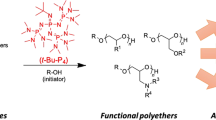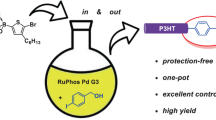Abstract
Hetero-telechelic polymers (HTPs) with different reactive functional groups at the chain ends, which can react selectively with other molecules or surfaces to form new chemical bonds, are attractive in the context of reaction selectivity and elaborate polymer modification. However, effective synthetic routes to HTPs remain limited, especially those based on postpolymerization modification processes. Herein, we report a versatile method based on reversed-phase column chromatography for separation of modified poly(ethylene glycol) with a hydroxy group and a maleimide–furan adduct at its α and ω ends. Protection of the maleimide end with furan protects the imide moiety from hydrolysis during the purification process, and the furan protecting group can be reversibly removed by heating. Furthermore, the resulting hetero-telechelic polymers were successfully applied to syntheses of block copolymers.
This is a preview of subscription content, access via your institution
Access options
Subscribe to this journal
Receive 12 print issues and online access
$259.00 per year
only $21.58 per issue
Buy this article
- Purchase on Springer Link
- Instant access to full article PDF
Prices may be subject to local taxes which are calculated during checkout






Similar content being viewed by others
References
Webster OW. Living polymerization methods. Science 1991;251:887–93.
Kolb HC, Finn MG, Sharpless KB. Click chemistry: diverse chemical function from a few good reactions. Angew Chem Int. 2001;40:2004–21.
Iha RK, Wooley KL, Nyström AM, Burked DJ, Kade MJ, Hawker CJ. Applications of orthogonal ‘Click’ Chemistries in the synthesis of functional soft materials. Chem Rev. 2009;109:5620–86.
Patten TE, Matyjaszewski K. Atom transfer radical polymerization and the synthesis of polymeric materials. Adv Mater. 1998;10:901–15.
Willcock H, O’Reilly RK. End group removal and modification of RAFT polymers. Polym Chem. 2010;1:149–57.
Lo Verso F, Likos CN. End-functionalized polymers: versatile building blocks for soft materials. Polymer. 2008;49:1425–34.
Zhou D, Zhu L-W, Wu B-H, Xu Z-K, Wan L-S. End-functionalized polymers by controlled/living radical polymerizations: synthesis and applications. Polym Chem. 2022;13:300–58.
Kakuchi R, Theato P. Sequential post-polymerization modification reactions of poly(pentafluorophenyl 4-vinylbenzenesulfonate). Polym Chem. 2014;5:2320.
Hamaguchi K, Ichikawa R, Kajiyama S, Torii S, Hayashi Y, Kumaki J, et al. Gemini thermotropic smectic liquid crystals for two-dimensional nanostructured water-treatment membranes. ACS Appl Mater Interfaces. 2021;13:20598–605.
Yanagisawa Y, Nan Y, Okuro K, Aida T. Mechanically robust, readily repairable polymers via tailored noncovalent cross-linking. Science. 2018;359:72–76.
Wang Y, Quinsaat JEQ, Ono T, Maeki M, Tokeshi M, Isono T, et al. Enhanced dispersion stability of gold nanoparticles by the physisorption of cyclic poly(ethylene glycol). Nat Commun. 2020;11:6089.
Aoki D. A rational entry to cyclic polymers via spontaneous and selective cyclization reactions. Polym J. 2021;53:257–69.
Laurent BA, Grayson SM. Synthetic approaches for the preparation of cyclic polymers. Chem Soc Rev. 2009;38:2202.
Schulz M, Tanner S, Barqawi H, Binder WH. Macrocyclization of polymers via ring-closing metathesis and azide/alkyne- ‘click’ -reactions: an approach to cyclic polyisobutylenes. J Polym Sci Part A Polym Chem. 2010;48:671–80.
Sun H, Kabb CP, Sims MB, Sumerlin BS. Architecture-transformable polymers: reshaping the future of stimuli-responsive polymers. Prog Polym Sci. 2019;89:61–75.
Sato H, Aoki D, Marubayashi H, Uchida S, Sogawa H, Nojima S, et al. Topology-transformable block copolymers based on a rotaxane structure: change in bulk properties with same composition. Nat Commun. 2021;12:6175.
Honda S, Yamamoto T, Tezuka Y. Tuneable enhancement of the salt and thermal stability of polymeric micelles by cyclized amphiphiles. Nat Commun. 2013;4:1574.
Honda S, Toyota T. Photo-triggered solvent-free metamorphosis of polymeric materials. Nat Commun. 2017;8:502.
Ree BJ, Satoh Y, Isono T, Satoh T. Influence of topological confinement on nanoscale film morphologies of tricyclic block copolymers. Macromolecules. 2021;54:4120–7.
Muramatsu Y, Takasu A. Synthetic innovations for cyclic polymers. Polym J. 2022;54:121–32.
Shibayama M. Structure-mechanical property relationship of tough hydrogels. Soft Matter. 2012;8:8030.
Gong JP. Why are double network hydrogels so tough? Soft Matter. 2010;6:2583.
Noda Y, Hayashi Y, Ito K. From topological gels to slide‐ring materials. J Appl Polym Sci. 2014;131:40509.
Liu C, Morimoto N, Jiang L, Kawahara S, Noritomi T, Yokoyama H, et al. Tough hydrogels with rapid self-reinforcement. Science. 2021;372:1078–81.
Sakai T, Matsunaga T, Yamamoto Y, Ito C, Yoshida R, Suzuki S, et al. Design and fabrication of a high-strength hydrogel with ideally homogeneous network structure from tetrahedron-like macromonomers. Macromolecules. 2008;41:5379–84.
Bin Imran A, Esaki K, Gotoh H, Seki T, Ito K, Sakai Y, et al. Extremely stretchable thermosensitive hydrogels by introducing slide-ring polyrotaxane cross-linkers and ionic groups into the polymer network. Nat Commun. 2014;5:5124.
Park J, Murayama S, Osaki M, Yamaguchi H, Harada A, Matsuba G, et al. Extremely rapid self‐healable and recyclable supramolecular materials through planetary ball milling and host–guest interactions. Adv Mater. 2020;32:2002008.
Fujiyabu T, Sakumichi N, Katashima T, Liu C, Mayumi K, Chung U, et al. Tri-branched gels: rubbery materials with the lowest branching factor approach the ideal elastic limit. Sci Adv. 2022;8:1–10.
Haag R, Kratz F. Polymer therapeutics: concepts and applications. Angew Chem Int. 2006;45:1198–215.
Roth PJ, Jochum FD, Zentel R, Theato P. Synthesis of hetero-telechelic α,ω bio-functionalized polymers. Biomacromolecules. 2010;11:238–44.
Tasdelen MA, Kahveci MU, Yagci Y. Telechelic polymers by living and controlled/living polymerization methods. Prog Polym Sci. 2011;36:455–567.
Gauthier MA, Gibson MI, Klok HA. Synthesis of functional polymers by post-polymerization modification. Angew Chem Int. 2009;48:48–58.
Herzberger J, Niederer K, Pohlit H, Seiwert J, Worm M, Wurm FR, et al. Polymerization of ethylene oxide, propylene oxide, and other alkylene oxides: synthesis, novel polymer architectures, and bioconjugation. Chem Rev. 2016;116:2170–243.
Pohlit H, Worm M, Langhanki J, Berger-Nicoletti E, Opatz T, Frey H. Silver oxide mediated monotosylation of poly(ethylene glycol) (PEG): heterobifunctional PEG via polymer desymmetrization. Macromolecules. 2017;50:9196–206.
Nagasaki Y, Kutsuna T, Iijima M, Kato M, Kataoka K, Kitano S, et al. Formyl-ended heterobifunctional poly(ethylene oxide): synthesis of poly(ethylene oxide) with a formyl group at one end and a hydroxyl group at the other end. Bioconjug Chem. 1995;6:231–3.
Ishii T, Yamada M, Hirase T, Nagasaki Y. New synthesis of heterobifunctional poly(ethylene glycol) possessing a pyridyl disulfide at one end and a carboxylic acid at the other end. Polym J. 2005;37:221–8.
Arai T, Jang K, Koyama Y, Asai S, Takata T. Versatile supramolecular cross-linker: a rotaxane cross-linker that directly endows vinyl polymers with movable cross-links. Chem - A Eur J. 2013;19:5917–23.
Jang K, Iijima K, Koyama Y, Uchida S, Asai S, Takata T. Synthesis and properties of rotaxane-cross-linked polymers using a double-stranded γ-CD-based inclusion complex as a supramolecular cross-linker. Polymer. 2017;128:379–85.
Mizutani N, Hosono N, Le Ouay B, Kitao T, Matsuura R, Kubo T, et al. Recognition of polymer terminus by metal-organic frameworks enabling chromatographic separation of polymers. J Am Chem Soc. 2020;142:3701–5.
Wei Y, Zhuo R, Jiang X. Separation of polyethylene glycols and maleimide-terminated polyethylene glycols by reversed-phase liquid chromatography under critical conditions. J Sep Sci. 2016;39:4305–13.
Wei YZ, Zhuo RX, Jiang XL. Separation of polyethylene glycols and amino-terminated polyethylene glycols by high-performance liquid chromatography under near critical conditions. J Chromatogr A. 2016;1447:122–8.
Wei YZ, Chu YF, Uliyanchenko E, Schoenmakers PJ, Zhuo RX, Jiang XL. Separation and characterization of benzaldehyde-functional polyethylene glycols by liquid chromatography under critical conditions. Polym Chem. 2016;7:7506–13.
Annunziato ME, Patel US, Ranade M, Palumbo PS. P-maleimidophenyl isocyanate: a novel heterobifunctional linker for hydroxyl to thiol coupling. Bioconjug Chem. 1993;4:212–8.
Takashima R, Kida J, Aoki D, Otsuka H. Maleimidophenyl isocyanates as postpolymerization modification agents and their applications in the synthesis of block copolymers. J Polym Sci Part A Polym Chem. 2019;57:2396–406.
Takashima R, Ohira M, Yokochi H, Aoki D, Li X, Otsuka H. Characterization of N -phenylmaleimide-terminated poly(ethylene glycol)s and their application to a tetra-arm poly(ethylene glycol) gel. Soft Matter. 2020;16:10869–75.
Makiguchi K, Satoh T, Kakuchi T. Diphenyl phosphate as an efficient cationic organocatalyst for controlled/living ring-opening polymerization of δ-valerolactone and ε-caprolactone. Macromolecules. 2011;44:1999–2005.
Ray WJ, Puvathingal JM. A simple procedure for removing contaminating aldehydes and peroxides from aqueous solutions of polyethylene glycols and of nonionic detergents that are based on the polyoxyethylene linkage. Anal Biochem. 1985;146:307–12.
Acknowledgements
This research was supported by the AGC Research Collaboration, trust research/joint research funds from the Asahi Kasei Corporation, and the Fujikura Foundation.
Author information
Authors and Affiliations
Corresponding authors
Ethics declarations
Conflict of interest
The authors declare no competing interests.
Additional information
Publisher’s note Springer Nature remains neutral with regard to jurisdictional claims in published maps and institutional affiliations.
Supplementary information
Rights and permissions
About this article
Cite this article
Sato, T., Takashima, R., Aoki, D. et al. Isolation of hetero-telechelic polyethylene glycol with groups of different reactivity at the chain ends. Polym J 54, 1321–1329 (2022). https://doi.org/10.1038/s41428-022-00676-2
Received:
Revised:
Accepted:
Published:
Issue Date:
DOI: https://doi.org/10.1038/s41428-022-00676-2



